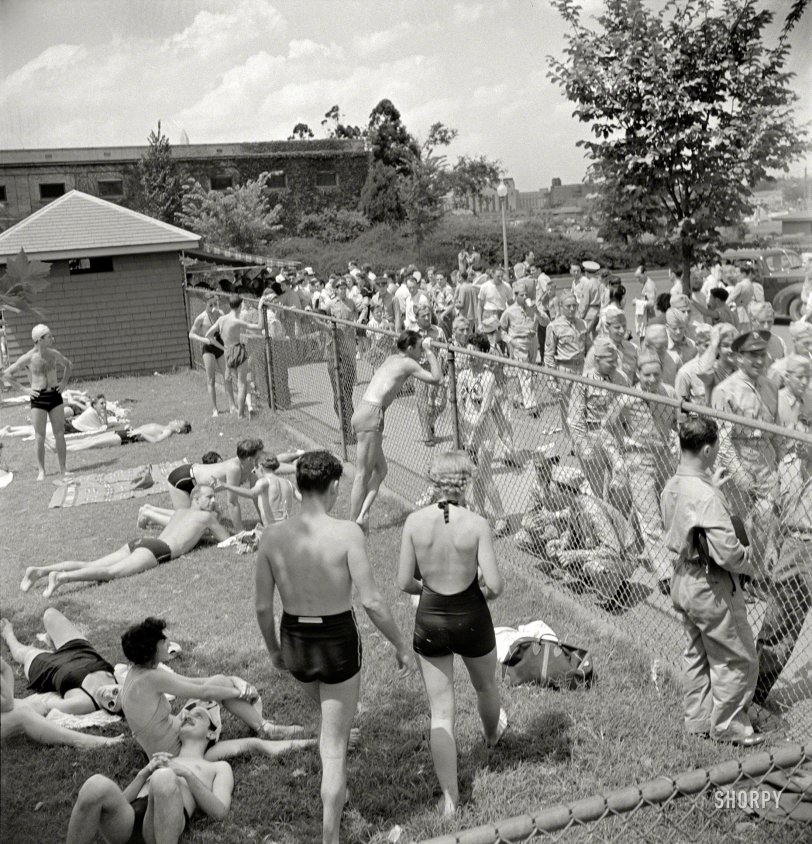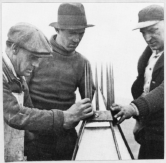


Framed or unframed, desk size to sofa size, printed by us in Arizona and Alabama since 2007. Explore now.
Shorpy is funded by you. Patreon contributors get an ad-free experience.
Learn more.

- Baldwin 62303
- Baldwin VO-1000
- Cold
- No expense spared
- Tough Guys
- Lost in Toyland
- And without gloves
- If I were a blindfolded time traveler
- Smoke Consumer Also Cooks
- Oh that stove!
- Possibly still there?
- What?!?
- $100 Reward
- Freeze Frame
- Texas Flyer wanted
- Just a Year Too Soon
- WWII -- Replacing men with women at the railroad crossing.
- Yes, Icing
- You kids drive me nuts!
- NOT An Easy Job
- I wonder
- Just add window boxes
- Icing Platform?
- Indiana Harbor Belt abides
- Freezing haze
- Corrections (for those who care)
- C&NW at Nelson
- Fallen Flags
- A dangerous job made worse
- Water Stop
Print Emporium
Adult Swim: 1942

July 1942. "Sunbathers on the grass next to the municipal swimming pool on Sunday." The pasty white underbelly of wartime Washington. Medium format negative by Marjory Collins for the Office of War Information. View full size.
Top of Washington Monument
The top of the Washington Monument can be seen in the background. Here's a 1934 photo of the top:

East Potomac Park
Yes, thank you, you're right. My range estimate was way off. It's across the channel in East Potomac Park.
The pool may have been a WPA project. People could swim in the Tidal Basin until the late 1920s.
Location
East Potomac Pool on Hain's Point is probably where photo was taken. Same location as ball game with UFO in background, boy and girl with bikes lying on grass and two girl swimmers.
Swimming
I think this is the building.
There is a pool here too.
SW DC
If you look a little to the right of the lamppost you will see the USDA building, which runs along C Street SW from 12th to 14th Streets. The pool must have been near where 12th Street merges into Maine Avenue. The lanes of I-395 run through the location today.
July in DC
July in the District of Columbia can be blisteringly hot. It can easily reach 100 degrees that time of year. I'm amazed that the guys in uniform don't look a lot sloppier.
Back of the sub
Building in the background is now the U.S. Park Police Central Substation.
Pasty White Indeed
And the brothers and sisters would be swimming ... where, exactly? Not to be more than usually preachy, but this shot is a pretty good indication that such places in our nation's capital were still segregated back then (like military units, housing areas, and almost every other public facility). It is fitting for Americans of all races to remember that the good old days were replete with bad features and that, as a people, we have indeed come a long way since then.
Men's Swimwear
Sewickley, I made the same comment several weeks ago when there were swim pictures from 1939 and then right after the war. In the pre-war pictures all the men had swimsuits with tops and after only bottoms. I guessed that perhaps it was because GI's bathed in just their shorts and when they came back it just carried over. However it appears the change was even quicker (as you commented) as this picture in 1942 shows only one male with a swim top. I am like you curious as to what caused the change. Perhaps we have someone from the fashion industry that could answer this question.
[Googling {men's swimwear history} gets you off to a good start. - tterrace]
I'm Not a Big Fan
I'm just a little one with an oscillating gear drive, silhouetted inside the little window of the frame shack.
Casual, almost indifferent
What strikes me about this photo is the casual atmosphere of the scene. One might not realize a war was underway - the previous month, the US Navy had fought the critical battle of Midway.
The soldiers depicted in this photo have the casual, even sloppy appearance (headgear at improper angles; collars loosened, etc) of clerks assigned to DC area offices. If they had been recent trainees, one would hope that the spit and polish regime was still present.
Photo might be captioned: "At ease on the homefront".
More Men's Swimwear
10 and 15 years later, in the mid 1950s, when I was old enough to remember swimming pools, these lads, grown up and now fathers, were still wearing those Superman trunks. We kids, however, were stuck with little children's boxers.
Those were Philadelphia and South Jersey memories. A New York City friend says that up there, male swimmers went directly from old fashioned suits to boxers.
An urban legend is that a wartime shortage of cloth brought the end of coverup suits and also the arrival of bikinis.
Pasty White
In the 1960s I had the honour to serve in the US Navy at a sub base in Holy Loch, Scotland. After having been there for 18 months, my ship the USS Simon Lake was relieved by another, the USS Canopus. I transferred to the Canopus for another tour. Some of my new shipmates asked me how come I was sooo white. I pointed out that there was little sunshine in Scotland, and shortly they would be just as pasty, too.
Long story short, a nice tan was not a very important thing in 1942, unless you were Cary Grant.
The pasty white underbelly of wartime Washington
Imagine where all those guys in Army uniforms were eventually to go. They look so young.
But then I was 18 years + 3 months when my turn came.
Pool Pass?
Are the GIs just taking an opportunity to wander by the pool, sightseeing, or has the USO or other agency arranged for pool passes? If anyone knows which way the entrance is from this shot, maybe it would help figure that out.
Since it's early in the war, the U-boats are working right off the coast and probably more than one GI is thinking, "Hmmm, maybe I ought to work on my backstroke?" These guys knew they most likely weren't flying anywhere to fight, unless it was in a warplane going overseas, too.
Men's swimwear
Through the mid-1930s, tank tops seemed to be standard swimwear for me. By the early 1940s, nearly everyone wore trunks. Am I correct in thinking that the change happened very quickly? What caused the change in fashion?
























On Shorpy:
Today’s Top 5